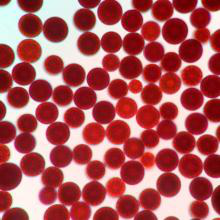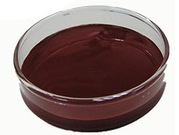14 Years Factory wholesale Astaxanthin Supply to Auckland
14 Years Factory wholesale Astaxanthin Supply to Auckland Detail:
[Latin Name] Haematococcus Pluvialis
[Plant Source] from China
[Specifications]1% 2% 3% 5%
[Appearance] Dark red Powder
[Particle size] 80 Mesh
[Loss on drying] ≤5.0%
[Heavy Metal] ≤10PPM
[Storage] Store in cool & dry area, keep away from the direct light and heat.
[Shelf life] 24 Months
[Package] Packed in paper-drums and two plastic-bags inside.
[Net weight] 25kgs/drum
Brief Introduction
Astaxanthin is a natural nutritional component, it can be found as a food supplement. The supplement is intended for human, animal, and aquaculture consumption.
Astaxanthin is a carotenoid. It belongs to a larger class of phytochemicals known as terpenes, which are built from five carbon precursors; isopentenyl diphosphate and dimethylallyl diphosphate . Astaxanthin is classified as a xanthophyll (originally derived from a word meaning “yellow leaves” since yellow plant leaf pigments were the first recognized of the xanthophyll family of carotenoids), but currently employed to describe carotenoid compounds that have oxygen-containing moities, hydroxyl or ketone , such as zeaxanthin and canthaxanthin. Indeed, astaxanthin is a metabolite of zeaxanthin and/or canthaxanthin, containing both hydroxyl and ketone functional groups. Like many carotenoids, astaxanthin is a colorful, lipid-soluble pigment. This colour is due to the extended chain of conjugated (alternating double and single) double bonds at the centre of the compound. This chain of conjugated double bonds is also responsible for the antioxidant function of astaxanthin (as well as other carotenoids) as it results in a region of decentralized electrons that can be donated to reduce a reactive oxidizing molecule.
Function:
1.Astaxanthin is a powerful antioxidant and may protect against oxidative damage to body tissues.
2.Astaxanthin can improve the immune response by increasing the number of antibody producing cells.
3.Astaxanthin is a potential candidate to treat neurodegenerative disease such as Alzhimer and Parkinson diease.
4.Astaxanthin dan reduce UVA-light damage to skin such as sunburn, inflammation, ageing and skin cancer.
Application
1.When applied in pharmaceutical field, astaxanthin powder has the good function of antineoplastic;
2.When applied in health food field, astaxanthin powder is used as food additives for pigment and health care;
3.When applied in cosmetic field, astaxanthin powder has the good function of antioxidant and anti-aging;
4.When applied in animal feeds field, astaxanthin powder is used as animal feed additive to impart coloration, including farm-raised salmon and egg yolks.
Product detail pictures:

Related Product Guide:
"Sincerity, Innovation, Rigorousness, and Efficiency" would be the persistent conception of our enterprise with the long-term to build with each other with consumers for mutual reciprocity and mutual advantage for 14 Years Factory wholesale Astaxanthin Supply to Auckland , The product will supply to all over the world, such as: Palestine, Nigeria, Canada, Since its foundation , the company keeps living up to the belief of "honest selling , best quality , people-orientation and benefits to customers. " We are doing everything to offer our customers with best services and best products . We promise that we'll be responsible all the way to the end once our services begin.
I fill my bathtub with 51 gallons of glue, food coloring, and Borax!
Wanna do my captions? ➽ https://bit.ly/2pDaiIV
Subscribe and become a GUAV! ➽ https://bit.ly/GUAVAJUICE
Guava Juice Merchandise ➽https://www.crowdmade.com/guavajuice
Send me some FAN ART! ➽ https://bit.ly/GuavaFB
Follow me on the Social Media!
—————————————————————-
Twitter ➽ https://www.twitter.com/GuavaRoi
Instagram ➽ https://www.instagram.com/GuavaRoi
Facebook ➽ https://www.facebook.com/GuavaRoi
Snapchat ➽ https://www.youtube.com/add/WhereIsRoi
Watch some of these AWESOME playlists!
—————————————————————-
Randomness! ➽ – https://bit.ly/GuavaRandom
Challenges! ➽ – https://bit.ly/GuavaCHALLENGES
Roblox! ➽ – https://bit.ly/GuavaROBLOX
Tutorials!! ➽ https://bit.ly/GuavaTUTORIALS
╘[◉﹃◉]╕ ╘[◉﹃◉]╕╘[◉﹃◉]╕
What’s up YouTube! Welcome to Guava Juice. I post two videos a day at 12PM and 3PM PST! You may know me as Roi Wassabi from Wassabi Productions. I left that channel to start this channel is a new chapter of my life. You can call me Guava Roi or Guavs or whatever you want!
On here, you’ll find games from Roblox, Happy Wheels, Horror Games, and random games you’ve never heard of. You’ll also find INSANE challenges, filling up my BATH TUB with random things, COOL experiments, SILLY DIY, and random shenanigans that you’ll love! Subscribe and become a GUAV! You won’t be disappointed!
Be yourself, be humble, and inspire!
Outro Song Dr. Dre – The Next Episode (San Holo Remix)
Stay Juicy! ( ́ ◕◞ε◟◕`)
#stayjuicy #guavajuice
Good quality, reasonable prices, rich variety and perfect after-sales service, it's nice!







